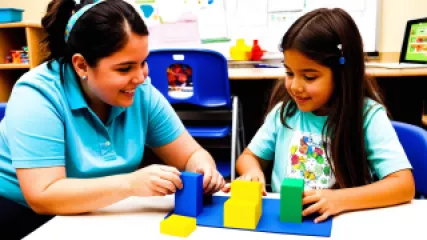10 Proven Strategies for Learning Disability Therapy Sessions
10 Proven Strategies for Learning Disability Therapy Sessions
Learning disabilities can present significant challenges for individuals, but with the right support and guidance, remarkable progress can be made. In this comprehensive list, we will explore 10 proven strategies that can help transform the therapy experience for those dealing with learning disabilities.
1. Personalized Approach
The first and most crucial step in effective learning disability therapy is to adopt a highly personalized approach. Each individual's challenges, strengths, and learning styles are unique, and a one-size-fits-all solution simply won't cut it. Experienced therapists understand the importance of deeply understanding their clients' specific needs and tailoring the therapy sessions accordingly.
As Michelle Cummings, a renowned learning disability specialist, explains, "The key to successful therapy is to meet the client where they are. We can't assume that what works for one person will work for another. It's all about careful assessment, creative problem-solving, and a willingness to adapt the approach as needed."
2. Multi-Sensory Approach
Learning disabilities often involve difficulties in processing information through traditional methods, such as reading or listening. By incorporating a multi-sensory approach, therapists can engage multiple senses simultaneously, enhancing the learning experience and increasing the chances of information retention.
This can involve incorporating visual aids, such as images, diagrams, or videos, as well as kinesthetic activities that encourage physical movement and hands-on learning. The integration of auditory, visual, and tactile elements creates a more comprehensive and engaging learning environment.
3. Scaffolding and Gradual Release
Scaffolding is a teaching technique that involves providing temporary support and gradually reducing it as the learner becomes more independent. In the context of learning disability therapy, this approach helps break down complex tasks into manageable steps, allowing the individual to build confidence and mastery incrementally.
The therapist begins by providing extensive guidance and support, and then gradually releases the learner to take on more responsibility as their skills improve. This gradual release of responsibility encourages the development of self-reliance and problem-solving abilities.
4. Repetition and Reinforcement
Repetition and reinforcement are essential elements in learning disability therapy. Individuals with learning disabilities often require multiple exposures to new concepts and skills before they become firmly ingrained. Therapists employ a variety of techniques, such as practice exercises, review sessions, and regular feedback, to ensure that the learned material is solidified and can be readily applied in real-world situations.
Additionally, positive reinforcement, such as praise, encouragement, and tangible rewards, can significantly enhance the learning process and boost the individual's motivation and self-confidence.
5. Multidisciplinary Collaboration
Effective learning disability therapy often requires a collaborative approach involving various professionals, including educators, speech and language therapists, occupational therapists, and mental health specialists. By working together, these experts can provide a comprehensive and coordinated plan that addresses the individual's unique needs from multiple angles.
This collaborative effort ensures that the therapy sessions are aligned with the individual's overall educational and developmental goals, and that any co-occurring challenges, such as mental health or sensory processing issues, are also addressed.
6. Adaptive Technology
Advancements in technology have revolutionized the field of learning disability therapy, providing a wealth of tools and resources to support individuals in their learning journey. Assistive technologies, such as text-to-speech software, specialized apps, and interactive learning platforms, can significantly enhance the learning experience and help overcome various barriers.
Therapists well-versed in these technologies can guide clients in exploring and effectively utilizing these tools, empowering them to take control of their learning and access information in a more accessible and engaging manner.
7. Emotional Support and Confidence Building
Learning disabilities can often be accompanied by emotional challenges, such as low self-esteem, anxiety, and frustration. Effective learning disability therapy recognizes the importance of addressing these emotional aspects alongside the academic or skill-based components.
Therapists create a supportive and encouraging environment, validating the individual's experiences and helping them develop coping strategies to manage emotional obstacles. By building confidence and fostering a growth mindset, the individual is better equipped to navigate the challenges of their learning disability and ultimately achieve their goals.
8. Functional Life Skills
In addition to academic support, learning disability therapy should also focus on developing functional life skills. This includes tasks such as time management, organization, problem-solving, and self-advocacy, which are crucial for navigating daily life and achieving independence.
Therapists work with individuals to identify areas of difficulty and provide practical strategies and tools to enhance these essential life skills. By empowering individuals with learning disabilities to manage their own lives more effectively, they gain a sense of control and confidence that positively impacts their overall well-being.
9. Ongoing Evaluation and Adaptation
Learning disabilities are often complex and can evolve over time, requiring continuous evaluation and adaptation of the therapy approach. Experienced therapists regularly assess the individual's progress, identify new areas of need, and make adjustments to the treatment plan accordingly.
This iterative process ensures that the therapy remains relevant and effective, addressing the individual's changing needs and capitalizing on their growing strengths. Regular check-ins and assessments allow therapists to fine-tune the strategies and celebrate the individual's achievements along the way.
10. Collaboration with Families and Caregivers
Learning disability therapy is most effective when it involves a collaborative partnership between the therapist, the individual, and their family or caregivers. By engaging families and caregivers in the therapy process, therapists can ensure that the strategies and techniques being used are reinforced and supported in the individual's everyday life.
This collaboration also allows for the sharing of valuable insights and observations, as well as the development of a cohesive support network that empowers the individual to apply their newfound skills and strategies in various settings, ultimately leading to greater success and independence.
By implementing these 10 proven strategies, learning disability therapy can become a transformative experience, empowering individuals to overcome their challenges, develop essential skills, and unlock their full potential. Remember, every individual's journey is unique, and a personalized, adaptable approach is key to achieving the most meaningful and lasting results.
As Mackenzie Perry, a seasoned learning disability therapist, eloquently states, "It's not about finding a quick fix or a one-size-fits-all solution. It's about honoring the individual, fostering their strengths, and providing the specialized support they need to thrive. With patience, creativity, and a deep commitment to their success, we can help individuals with learning disabilities achieve remarkable progress and life-changing outcomes."






